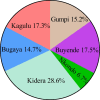Unravelling taboos and cultural beliefs associated with hidden hunger among pregnant and breast-feeding women in Buyende district Eastern Uganda
- PMID: 38693532
- PMCID: PMC11064283
- DOI: 10.1186/s13002-024-00682-z
Unravelling taboos and cultural beliefs associated with hidden hunger among pregnant and breast-feeding women in Buyende district Eastern Uganda
Abstract
Background: Food taboos and cultural beliefs among pregnant and breast-feeding women influence their food consumption patterns and hence the health of women and unborn children. Cognizant of their neglect in programs aimed to ameliorate hidden hunger among pregnant and breast-feeding women in Buyende and other resource-poor communities in sub-Saharan Africa, we opted for a study to unravel them to inform program design.
Methods: We documented food taboos and beliefs amongst pregnant and breast-feeding women from six sub-counties of Buyende district in Eastern Uganda. A mixed-methods approach was used, which was comprised of questionnaire interviews with 462 women, eight focus group discussions with 6-10 participants in each and a total of 15 key informant interviews.
Results: The present study revealed that 129 (27.9%) of the respondents practice food taboos and adhere to cultural beliefs related to their dietary habits during pregnancy and breast-feeding that are fuelling the prevalence of hidden hunger. The most tabooed foods during pregnancy were sugarcane (17.8%), fishes which included lung fish, catfish and the Lake Victoria sardine (Rastrineobola argentea) (15.2%), oranges (6.6%), pineapples (5.9%), eggs (3.3%), chicken (3.3%) and cassava, mangoes and Cleome gynandra (each at 3%). Most foods were avoided for reasons associated with pregnancy and labour complications and undesirable effects on the baby. Most women learnt of the taboos and beliefs from the elders, their own mother, grandparents or mother-in-law, but there was also knowledge transmission in social groups within the community.
Conclusions: The taboos and cultural beliefs in the study area render pregnant and breast-feeding women prone to micronutrient deficiency since they are denied consumption of a diversity of nutritious foods. There is a need to educate such women about consumption of nutrient-rich foods like fish, eggs, fruits and vegetables in order to improve their health, that of the unborn and children being breast fed. Additionally, culturally appropriate nutrition education may be a good strategy to eliminate inappropriate food taboos and beliefs with negative impact on the health of pregnant and breast-feeding women.
Keywords: Breast-feeding women; Cultural beliefs; Food taboos; Maternal health; Micronutrient deficiency.
© 2024. The Author(s).
Conflict of interest statement
The authors declare that they have no competing interests.
Figures
Similar articles
-
Food Taboos and Cultural Beliefs Influence Food Choice and Dietary Preferences among Pregnant Women in the Eastern Cape, South Africa.Nutrients. 2019 Nov 5;11(11):2668. doi: 10.3390/nu11112668. Nutrients. 2019. PMID: 31694181 Free PMC article.
-
Food-related taboos and misconceptions during pregnancy among rural communities of Illu Aba Bor zone, Southwest Ethiopia. A community based qualitative cross-sectional study.BMC Pregnancy Childbirth. 2021 Apr 17;21(1):309. doi: 10.1186/s12884-021-03778-6. BMC Pregnancy Childbirth. 2021. PMID: 33865339 Free PMC article.
-
Dietary habits, food taboos, and perceptions towards weight gain during pregnancy in Arsi, rural central Ethiopia: a qualitative cross-sectional study.J Health Popul Nutr. 2016 Jul 25;35(1):22. doi: 10.1186/s41043-016-0059-8. J Health Popul Nutr. 2016. PMID: 27456151 Free PMC article.
-
Food taboos during pregnancy.Health Care Women Int. 2020 Feb;41(2):159-168. doi: 10.1080/07399332.2019.1574799. Epub 2019 Apr 18. Health Care Women Int. 2020. PMID: 30998436 Review.
-
Animal-based food taboos during pregnancy and the postpartum period of Southeast Asian women - A review of literature.Food Res Int. 2019 Jan;115:480-486. doi: 10.1016/j.foodres.2018.10.026. Epub 2018 Oct 9. Food Res Int. 2019. PMID: 30599968 Review.
Cited by
-
Food taboos among indigenous pregnant women of Khagrachari District, Bangladesh.SAGE Open Med. 2025 May 26;13:20503121251342979. doi: 10.1177/20503121251342979. eCollection 2025. SAGE Open Med. 2025. PMID: 40432831 Free PMC article.
-
A study on traditional food practices and taboo during pregnancy and lactation in tribal population of Eastern Gujarat.J Family Med Prim Care. 2025 Apr;14(4):1333-1337. doi: 10.4103/jfmpc.jfmpc_1505_24. Epub 2025 Apr 25. J Family Med Prim Care. 2025. PMID: 40396114 Free PMC article.
References
-
- Kumar DM, Irshath AA, Rajan AP, Rajan AP. Solving hidden hunger: contributions of various sectors—A review. IJRAR. 2023;10(2):724–744.
-
- Von Grebmer K, Bernstein J, Hossain N, Brown T, Prasai N, Yohannes PF, Sonntag A, Zimmerman SM, Towey O. Global Hunger Index: the inequalities of hunger. Intl Food Policy Res Inst. 2017;2017:3.
-
- Jeje O, Oluwafemi G, Omowaye-Taiwo O. Mitigation of hidden hunger through biofortication: an appraisal. Int J Food Sci Nutr Int J Food Sci Nutr. 2023;6(1):13–29.
MeSH terms
LinkOut - more resources
Full Text Sources
Medical



